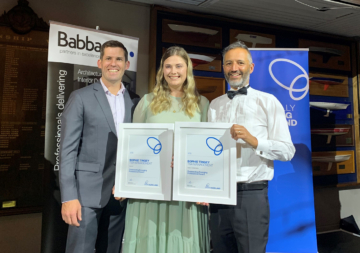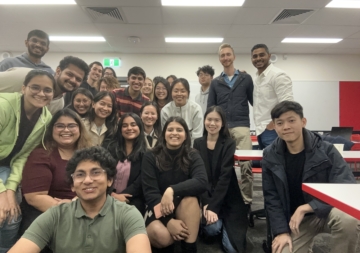
12 May 2023
Unlocking growth opportunities for regional Victoria throughout the Commonwealth Games
With significant amounts of Commonwealth Games investment directly benefiting the Commonwealth Games Host Cities, and a heavily constrained state budget, how do we make sure that Victoria’s other regions are not left behind?
Summary
The Victorian Commonwealth Games in 2026 represent an important opportunity for regional Victoria with $2.6 billion[1] in public expenditure committed to sporting, community and transport infrastructure across Victoria’s largest regional cities. It is expected that the Games will create more than 7,500 jobs[2] and leave a lasting legacy through the creation of additional housing and world-class sporting facilities.
The regional model for these games makes them distinct from previous Games, which have tended to centre activity within a single metropolitan region.
To support this regional model, significant investments are planned and underway to prepare for the sporting and cultural events to be held in Geelong, Bendigo, Ballarat and the Latrobe Valley. The channelling of public sector money into these regions will also stimulate private sector activity across a range of sectors, from construction to hospitality and the arts. Following the completion of the Games, the populations of these regions will derive ongoing benefits from this new investment, with wealth generated by regional businesses and workers continuing to circulate through local economies.
The unprecedented level of capital investment to be directed at some regional cities is clearly good news for regional Victoria. However, large parts of regional Victoria are set to miss out on the infrastructure windfall. In the context of growing economic uncertainty, and an increasingly constrained State Government budget, other parts of regional Victoria may struggle to attract the level of investment to which they are accustomed and which traditionally fosters regional economic sustainability.
[1] https://www.theage.com.au/politics/victoria/billions-for-regional-sport-as-victoria-gears-up-for-the-games-20220502-p5ahuv.html
[2] https://www.development.vic.gov.au/projects/2026-commonwealth-games?page=overview
______________________________________________________________________________________________
Compared with other Australian states, Victoria has a well-developed network of regional cities. The importance of the state’s regions is recognised in State Government strategic plans which recognise 10 regional cities[1] (see figure below). In addition to the 4 Commonwealth Games host cities, this list includes Shepparton, Wangaratta, Wodonga, Mildura, Horsham and Warrnambool.

Historically, the State plays an important role in promoting regional sustainability and equity across the state, with wealth generated by businesses and workers in Greater Melbourne deployed in the form of fiscal transfers to support sustainable economies and communities in regional Victoria.
The potential for reduced public and private investment in the wash-up of the Commonwealth Games presents a significant challenge for regions outside of the 4 largest Victorian regional cities. These regions will also need to contend with an increasingly uncertain national and global economy, low economic growth, high inflation, low wage growth and ongoing productivity challenges.
Given these looming challenges, it is important that Victorian regions position themselves to optimise their economic performance. There is now, more than ever, a critical role for local governments in identifying and facilitating appropriate interventions to support their regional economies and the communities that rely upon them.
Regional local governments must think creatively and strategically to best position their economies in the face of these challenges. It is therefore important that strong regional policy frameworks are in place supporting:
- Regional productivity growth,
- Sustainable levels of population change,
- (Public and private) investment attraction,
- New opportunities for tourism and visitation activity, and
- Local expenditure capture.

To meet these broad economic objectives, it is critical that the right local economic policy settings are in place. One way of doing this is to embark upon the development of a local economic development strategy. Done well, these strategies bring together local communities to map out economic development pathways that reflect regional strengths, opportunities and community aspirations.
These strategies will typically focus on the following:
- Pursuit of opportunities for economic diversification, reflecting existing capabilities and advantages, but also capitalising on emerging trends.
- Identification of critical constraints to growth, whether to do with insufficient utilities infrastructure or planning regulations.
- Setting out the need for a visitation and tourism plan, focused on maximising visitor attraction and length of stay by ensuring the local offer meets evolving preferences of national and international visitors.
- Identification of strategic and catalytic development opportunities, focussing on underutilised, well-located land parcels.
- Support for investment in the public realm to foster a sense of place, boost the functionality of local centres, support retention of local expenditures and visitor attraction.
- Identification of key major investment opportunities and adopting a strategic approach to exploit state and federal funding opportunities.
In coming years, regional Victoria will be the beneficiary of unprecedented levels of public investment. For those in and around the largest regional cities, this boom in investment will create immediate economic opportunities, with new community and sporting infrastructure supporting ongoing regional growth. Large parts of the state, however, are likely to miss out on many of these direct benefits. In these regions, local governments can help to ensure that local economies are best positioned to succeed through development of local economic development strategies.
About TSA Advisory
TSA Advisory works with clients to generate targeted solutions to overcome complicated challenges. We work across the project lifecycle to help our clients envision, develop, deliver, and optimise infrastructure to address demographic change and population growth and to support healthy and sustainable communities, where everyone can thrive.
TSA Advisory is a trusted advisor to local government and committed to advancing regional economic development. We have developed systems, tools and methodologies to assist in building a detailed understanding of local economies. In particular, TSA has created a Gross Regional Product (GRP) model for every state in Australia, offering GRP data at different geographical levels, including Statistical Area 1-4 and destination zones. GRP is calculated by summing up the gross value added (GVA) across all industries in a particular region or state. This economic indicator can be used to track the growth and development of different regions and states, identify areas of economic strengths and weaknesses, and inform policymaking decisions at the regional level. Additionally, GRP data can be used by businesses and investors to evaluate potential investment opportunities in different regions based on their economic performance. Please contact James Atkinson (james.atkinson@tsamgt.com) if you would like to discuss how we can assist you.
About the authors:
 James Atkinson – Senior Associate
James Atkinson – Senior Associate
James is an economist with a wealth of experience providing economic and strategic land use advice to public and private sector clients across Australia. James has tertiary qualifications in economics and urban planning and has worked with local governments on a range of different types of engagement, including economic development strategies, strategic land use planning, economic and land use forecasting, and infrastructure business cases.
 Leah Mosel – Associate
Leah Mosel – Associate
An experienced urban planner and strategist with 15 years’ experience in Local and State Government, Leah specialises in strategic planning, precinct delivery, placemaking and economic development. Leah has overseen the development and implementation of Government master planning and precinct strategies and various capital investment initiatives. Leah delivers place-based renewal strategies, local economic-development strategies, and business cases to deliver social and transport infrastructure.
 Dylan Wright – Consultant
Dylan Wright – Consultant
With strong analytical and problem-solving skills, Dylan provides strategic advice and economic analysis for a range of transport and urban renewal projects. He has successfully developed and implemented economic and financial models and supported the development of evidence-based advice for clients. Dylan has considerable experience developing business cases supported by well-developed implementation costs and providing clear direction for clients. He is a skilled report writer with a detail-orientated approach to data analysis.


